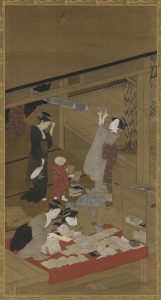A World’s Eye View of Preservation

Women Airing Books and Clothes, Katsukawa Shunsho 勝川春章 (1726-1792)
Freer Gallery of Art and Arthur M. Sackler Gallery Collection
What common sense cultural and religious practices can be found to have fostered inherent preservation of material culture through the ages, and how can libraries apply these low tech options to their own stewardship and promote their use to the general public?
It is often said that much of the cultural heritage that ends up in libraries & archives has been saved by accident: i.e. a document was saved from a fire pile or a manuscript was copied by various hands. In the case of the autumnal practice in Japan called Mushiboshi, or “drying bugs”: scrolls of paper, books, kimonos and other textiles are aired out in the courtyard to rid them of much of the insects and the humidity that are usually trapped in them during the summertime. This is a practice, performed at homes and temples alike, that is tied to the recognition of the changing of the seasons. We named our research project, The Mushiboshi Project, after this practice since it illustrates an activity that has both overt preservation purposes but that has also evolved into a major cultural & religious tradition in Japan.
Preservation in libraries and archives has become a specialized field that involves perennial institutional support of trained personnel, facilities and supplies. The cost of this investment can be out of the reach of smaller institutions and personal households. The work illustrated in this research intends to start identifying practices, sometimes with little or no cost, that have been part of the cultural or religious life around the world and how they can be applied and promoted to library, archives and the general public.

